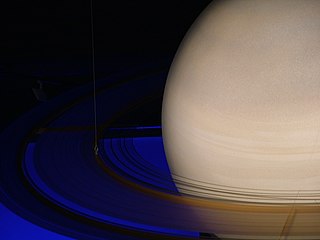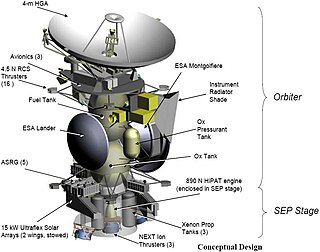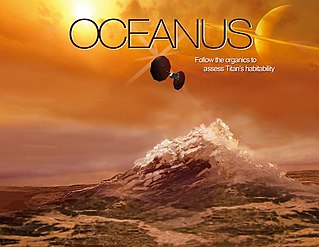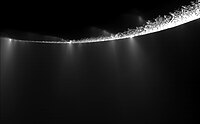
Astrobiology is a scientific field within the life and environmental sciences that studies the origins, early evolution, distribution, and future of life in the universe by investigating its deterministic conditions and contingent events. As a discipline, astrobiology is founded on the premise that life may exist beyond Earth.

Cassini–Huygens, commonly called Cassini, was a space-research mission by NASA, the European Space Agency (ESA), and the Italian Space Agency (ASI) to send a space probe to study the planet Saturn and its system, including its rings and natural satellites. The Flagship-class robotic spacecraft comprised both NASA's Cassini space probe and ESA's Huygens lander, which landed on Saturn's largest moon, Titan. Cassini was the fourth space probe to visit Saturn and the first to enter its orbit, where it stayed from 2004 to 2017. The two craft took their names from the astronomers Giovanni Cassini and Christiaan Huygens.

Enceladus is the sixth-largest moon of Saturn. It is about 500 kilometers in diameter, about a tenth of that of Saturn's largest moon, Titan. It is mostly covered by fresh, clean ice, making it one of the most reflective bodies of the Solar System. Consequently, its surface temperature at noon reaches only −198 °C, far colder than a light-absorbing body would be. Despite its small size, Enceladus has a wide range of surface features, ranging from old, heavily cratered regions to young, tectonically deformed terrain.
The New Frontiers program is a series of space exploration missions being conducted by NASA with the purpose of furthering the understanding of the Solar System. The program selects medium-class missions which can provide high science returns.

The tiger stripes of Enceladus consist of four sub-parallel, linear depressions in the south polar region of the Saturnian moon. First observed on May 20, 2005, by the Cassini spacecraft's Imaging Science Sub-system (ISS) camera, the features are most notable in lower resolution images by their brightness contrast from the surrounding terrain. Higher resolution observations were obtained by Cassini's various instruments during a close flyby of Enceladus on July 14, 2005. These observations revealed the tiger stripes to be low ridges with a central fracture. Observations from the Composite Infrared Spectrometer (CIRS) instrument showed the tiger stripes to have elevated surface temperatures, indicative of present-day cryovolcanism on Enceladus centered on the tiger stripes.

The exploration of Saturn has been solely performed by crewless probes. Three missions were flybys, which formed an extended foundation of knowledge about the system. The Cassini–Huygens spacecraft, launched in 1997, was in orbit from 2004 to 2017.

Whether there is life on Titan, the largest moon of Saturn, is currently an open question and a topic of scientific assessment and research. Titan is far colder than Earth, but of all the places in the Solar System, Titan is the only place besides Earth known to have liquids in the form of rivers, lakes, and seas on its surface. Its thick atmosphere is chemically active and rich in carbon compounds. On the surface there are small and large bodies of both liquid methane and ethane, and it is likely that there is a layer of liquid water under its ice shell. Some scientists speculate that these liquid mixes may provide prebiotic chemistry for living cells different from those on Earth.
Jonathan I. Lunine is an American planetary scientist and physicist. Lunine teaches at Cornell University, where he is the David C. Duncan Professor in the Physical Sciences and chair of the Department of Astronomy. Having published more than 380 research papers, Lunine is at the forefront of research into planet formation, evolution, and habitability. His work includes analysis of brown dwarfs, gas giants, and planetary satellites. Within the Solar System, bodies with potential organic chemistry and prebiotic conditions, particularly Saturn's moon Titan, have been the focus of Lunine's research.

Titan Saturn System Mission (TSSM) was a joint NASA–ESA proposal for an exploration of Saturn and its moons Titan and Enceladus, where many complex phenomena were revealed by Cassini. TSSM was proposed to launch in 2020, get gravity assists from Earth and Venus, and arrive at the Saturn system in 2029. The 4-year prime mission would include a two-year Saturn tour, a 2-month Titan aero-sampling phase, and a 20-month Titan orbit phase.
Journey to Enceladus and Titan (JET) is an astrobiology mission concept to assess the habitability potential of Enceladus and Titan, moons of Saturn.
Life Investigation For Enceladus (LIFE) was a proposed astrobiology mission concept that would capture icy particles from Saturn's moon Enceladus and return them to Earth, where they could be studied in detail for signs of life such as biomolecules.
Enceladus Explorer (EnEx) is a planned interplanetary orbiter and lander mission equipped with a subsurface maneuverable ice melting probe suitable to assess the existence of life on Saturn's moon Enceladus.
THEO is a feasibility study for a New Frontiers class orbiter mission to Enceladus that would directly sample its south pole water plumes in order to study its internal habitability and to search for biosignatures. Specifically, it would take advantage of the direct sampling opportunities of a subsurface ocean.

Oceanus is a NASA/JPL orbiter mission concept proposed in 2017 for the New Frontiers mission #4, but it was not selected for development. If selected at some future opportunity, Oceanus would travel to Saturn's moon Titan to assess its habitability. Studying Titan would help understand the early Earth and exoplanets which orbit other stars. The mission is named after Oceanus, the Greek god of oceans.

Explorer of Enceladus and Titan (E2T) is a space mission concept that would investigate the evolution and habitability of the Saturnian satellites Enceladus and Titan and is proposed by the European Space Agency in collaboration with NASA.

Enceladus Life Signatures and Habitability (ELSAH) is an astrobiology concept mission proposed in 2017 to NASA's New Frontiers program to send a spacecraft to Enceladus to search for biosignatures and assess its habitability. The Principal Investigator is Christopher P. McKay, an astrobiologist at NASA Ames Research Center, and the managing NASA center is Goddard Space Flight Center. No details of the mission have been made public, but observers speculate that it would be a plume-sampling orbiter mission.

The Ocean Worlds Exploration Program (OWEP) is a NASA program to explore ocean worlds in the outer Solar System that could possess subsurface oceans to assess their habitability and to seek biosignatures of simple extraterrestrial life.
The MAss Spectrometer for Planetary EXploration (MASPEX) is a mass spectrometer capable of high-resolution and high-sensitivity that allows the determination of a wide variety of chemical compounds in complex mixtures. This instrument will fly on board the planned Europa Clipper orbiter to explore Jupiter's moon Europa. This astrobiology mission will analyse the composition of Europa's surface while in orbit, and will directly assess its internal ocean habitability by flying through Europa's tenuous atmosphere.
The Enceladus Icy Jet Analyzer (ENIJA) is a time-of-flight mass spectrometer developed to search for prebiotic molecules like amino acids and biosignatures in the plumes of Saturn's moon Enceladus.
Christopher R. Glein is an American geochemist at the Southwest Research Institute in San Antonio, TX. He studies planetary science, astrobiology, and organic geochemistry. Glein was the first to describe how Saturn's moon Enceladus is the only known body, besides Earth, that has all of the requirements necessary for life. Glein has been involved in multiple spacecraft missions, leading to significant findings about Pluto, Enceladus, and Titan. In 2017, he was recognized for Outstanding Contributions to the ESA Rosetta Mission by the European Space Agency.


















